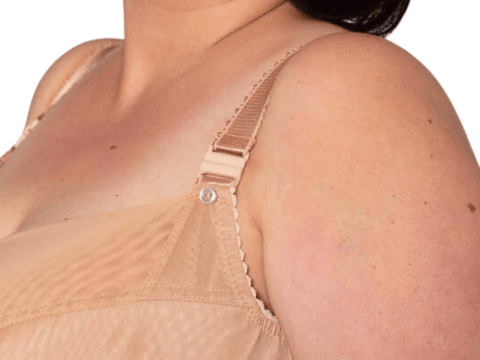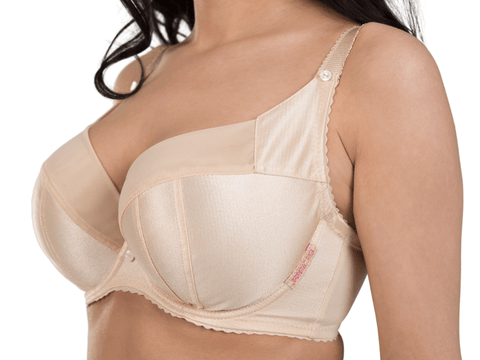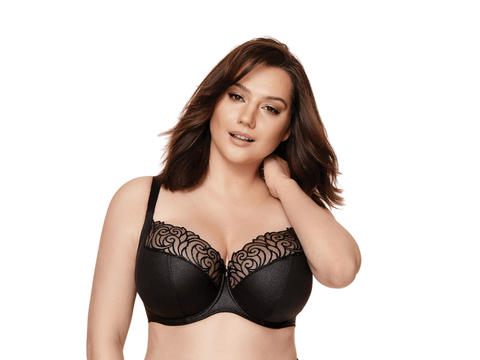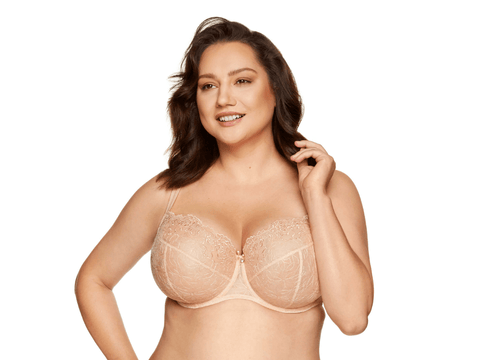FREE SHIPPING $120+ & 1 FREE SIZE EXCHANGE
FREE SHIPPING $120+ & 1 FREE SIZE EXCHANGE
Avoid Slips and Tissue Spillage: Tips to Prevent Your Bras Coming Off
September 03, 2023

Your bra is supposed to keep you supported and comfortable, but if you're full busted, chances are you've had moments of dreaded bra slips or spills out of your bra.
If you find that your bra is constantly slipping or your breasts spill out from the top or bottom of your cups, it's most likely due to the an improper fit of the bra's band and/or cup for your size, shape, and tissue type.
A properly fitting, snug band is most crucial to making sure your bra is providing the support needed to keep your bust secure and in place.
The shape of your breasts and the density of your breast tissue are also important to consider when addressing a tissue spillover or bra slipping issue.
Softer tissue is more prone to spillage but is also more compressible within your bra cups,. You may find success with full coverage styles, those that use more rigid low-stretch materials for the bottom of the cup.
Denser tissue is less prone to spillage, but less flexible in achieving proper cup fit. If you have dense tissue and are spilling out of your cups, you most likely need to increase your cup size and should consider bras that use more flexible materials in the top of the cup, and lower coverage shapes (e.g., plunge or balconette).
Finally, the way you put your bra on can have a serious impact on how it fits. If you're not using the "swoop and scoop" method, you may find that this helps you achieve a proper fit in which you feel lifted and supported without spillage.
To diagnose and fix your own issues with slippage or spillage, read on to learn about the causes of common fit concerns.
Reasons Behind Common Slippage and Spillage Issues
With a properly fitting bra, your breast tissue should feel encased and snuggly secure in your bra whether you're staying still or moving around.
If you're finding your breasts aren't staying put, then something isn't quite right with your bra fit. Fixing the issue starts with diagnosing not just the symptoms, but the root cause of the issue.
Issue 1: Center Spillage
Your Breasts Spill Out of Your Bra Cups When Leaning Over, or the Top Edge of the Cup Digs Into Your Tissue
This a very common complaint, and it's most likely because the cup size is too small, a cup shape mismatch for your tissue, or a combination of the two. While in some cases cup overflow is obvious and there is a clear "quad-boob" shape created, in other cases you may simply be wearing a cup shape that doesn't work for your breasts. Plunge styles and other low-coverage shapes are more likely to create spillage issues in the center of the cups, so choosing a fuller coverage style with the appropriate cup size can often fix this problem.
Issue 2: Bottom Spillage
Your Breast Tissue Comes Out of the Bottom of the Cup When Raising Your Arms, or Your Bra Gapes At the Center Gore
This is a sign that the band is significantly too loose and/or has too much stretch to support the weight of your breast tissue. A properly fitting band will keep the underwire in your cups flush against your ribcage whether your arms are up or down.
The center gore of your bra needs to sit flat against your chest. If it's gaping, it is often a combination of a too large/loose band, and a cup that is too small and does not have enough volume to fully encase your breast tissue. A too-loose band with a too small cup will create a gap at the inframammary fold and essentially no support.
Issue 3: Strap Slippage
Your Bra Straps Won't Stay Put and are Constantly Falling Down
If your shoulder straps are falling down, it's typically because they have been set too loose, or have stretched out over time. If that's the case, simply shortening the straps is an easy fix - ideally the straps should feel snug without digging into your shoulders or putting any noticeable pressure on them. Your bra's support should come from the band, so the straps should not serve as a weight-bearing part of the bra. Instead, they should be set just barely tight enough to hold the cups in the desired position. In most cases, this adjustment should be enough to keep the straps stable on your shoulders.

If you have tightened your straps and they continue to slip, this is most likely because your bra's straps are set too wide for your frame. If you have narrow or sloping shoulders and struggle with strap slippage, the solution will be finding bras with narrowly set vertical straps, or those with straps in a criss-cross shape. Ewa Michalak's FB style has a convenient and clever strap solution that allows you to unclasp the straps at the front (also a great option for nursing moms!) to wear them either vertically or crossed.

Easy Ways To Avoid Bra Spillage
Luckily, there are some simple fixes to keep your bra snug, secure and ensure it provides the support it should be.
Make Sure You're Wearing The Correct Band Size
Many women are wearing bras that are an incorrect size or fit for them. There are many reasons for this - it could be down to the bra style, or your local bra shop not carrying your true band or cup size.
To get enough support for your breasts, particularly those with larger breasts, you need to make sure the band is the correct circumference for your body and that the materials are strong enough to provide the support you need.
The rule of thumb for judging the right band tightness for a new bra is whether or not you can comfortably fit just one or, at most two, fingers under the band when it is fastened on it's loosest hook.
If you have a new bra in which you can easily slip multiple fingers under the band, you need a tighter band. Or, at the very least, tighten the clasp setting.
If you're finding that your breasts fall out the bottom of your bra in any circumstance, it's time for either a smaller band size or to replace a bra in which the band has loosened and lost its structural integrity.
Check Your Bra Cup
You can discover pretty quickly if your cup fits properly:
If you easily spill out when leaning over, have some side spillage, or end up with a quad-boob look, the cup size is too small. If you have tissue overflow, you need to go up a cup size (or more) to increase the volume of the cup and create enough space for your tissue.
If there's gaping at the top of the cup or any amount of wrinkling on the cup, then you likely need a smaller cup size.
NOTE: having issues with your bra cups doesn't necessarily mean you are wearing the wrong size. It could be that the style of bra isn't right for your breast shape.
Choose the Right Bra Style(s) For Your Breast Type
Breasts come in unique shapes, sizes, and density. Getting familiar with your tissue and shape is helpful for choosing bra styles that fit properly and helps you avoid spilling or slipping out of your bra.
Breasts are often talked about in terms of common shapes. You may not fit one of the categories neatly, and both your breast and density will likely change over time.
For women with large, natural busts that have not undergone breast augmentation surgery, the two most common shapes are the teardrop/bell shape and pendulous shape. You can read about common breast shapes and the styles that are well suited for each here.
In terms of tissue spillage for women with large breasts, the density of your breasts will determine how to fix the issue.
Soft Tissue: Add More Coverage and More Structure to Bra Cups
Style Recommendations for Soft Tissue:



Dense Tissue: Keep Bra Cups Flexible, but be Precise with Both Size and Shape
Style Recommendations for Dense Tissue:


Style Recommendation for Either Soft or Dense Tissue:

Double Check That Your Breast Tissue Is Sitting Correctly
Once you've found the perfect bra shape for your breast type, it's time to make sure that everything is sitting as it should be for maximum comfort, support, and a streamlined look.
To double-check, first want to make sure you've followed the "swoop and scoop" method of putting on your bra.
Step 1: Lean over while you put on your bra and allow gravity to help your tissue fill the cups.
Step 2: Clasp your bra while still leaning over.
Step 3: Stand or it up straight, then put a hand into each cup and scoop each breast up and in so that your nipple is in the very center of the cup and your breast tissue is fully encased.
It's surprising how such an easy technique can drastically take you from swimming in your bra to creating a smooth look under your outfits.
It's also an excellent indicator if your cup size is off, especially if there's some major cup overflow introduced after swooping and scooping.
Take Proper Care of Your Bra
Although most women tend to throw their bras into the washing machine, it's not the best way to keep your bra looking fresh.
Hand washing and air-drying are the best practices for keeping your bras in perfect shape.
When a bra is put through a washer and dryer, the heat and rigorous swishing can easily cause the cups to warp, and the materials to lose their elasticity.
Although it seems like an effort, taking the extra time to wash your bras properly and air dry them will save you money in the long run.
Why Doesn't My Bra Fit Anymore?
Even if you've followed all the tips above, there will be times when your bra isn't going to fit. Maybe it's the bra band digging in or wondering if you need a smaller cup size.
If your bra or body has changed and you find yourself dealing with bra slips or tissue overflow, you don't need to suffer in discomfort! it might be time to remeasure yourself and replace your bra for one that fits properly and keeps you snug and secure.

Bra Fit Problems: Solving Nightmares that Haunt Every Full-Bust Woman
October 24, 2025
Haunted by slipping straps, spooky spillage, or a band that just won’t behave? You’re not alon...

Wireless vs Wired Bras & Different Cuts for Full Busts
October 23, 2025
Choosing between wired and wireless bras for a full bust isn’t about taking sides - it’s about...

Sister Sizing in Bras: Support Secrets for Larger Cups
October 16, 2025
Navigating bra sizes can feel confusing especially when cup letters and band numbers don’t mat...
DD+ Bras Made in Poland Are Our Passion & Expertise
Specialized Polish Fit Expertise
Unlike many other boutiques, Polish bras are our specialty and our passion. At Miseczki, we work exclusively with the top Polish brands and understand the subtle nuances in fit, style, and support across all of the prominent brands. When you shop with us, you can feel confident you're receiving the best recommendations and expertise ensuring the highest likelihood of a great fit.
Personalized Fit Support
Have a question on sizing? Start with our size guide, complete with a Polish Bra Size Calculator to find your best starting point and brand conversions. Still unsure? Contact us, for tailored fit advice.
Loyalty Points and Discounts
Join our loyalty program to earn points for discounts on future orders. Enjoy seasonal offers, birthday perks, and occasional flash promotions. Sign up for our newsletter to stay up-to-date on our latest deals and arrivals, so you can make the most out of every purchase.
Fast Delivery and Exchanges
When you shop at Miseczki, you can count on fast, hassle-free, domestic delivery. All orders are shipped out of Chicago and typically arrive within a few days. Plus, if you need a size adjustment, our automated returns and exchange portal makes it easy to make a free sizing exchange. We also offer free returns for store credit, with an added 5% bonus credit on all eligible returns.
